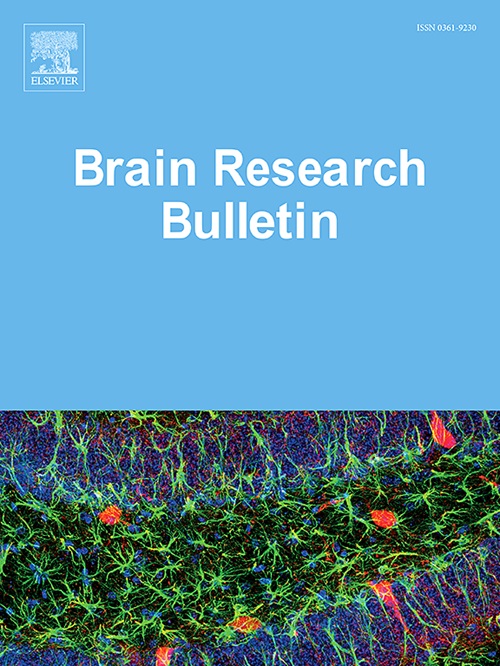A ketogenic diet decreases sevoflurane-induced burst suppression in rats
IF 3.5
3区 医学
Q2 NEUROSCIENCES
引用次数: 0
Abstract
Background
The brain requires a continuous fuel supply to support cognition and can get energy from glucose and ketones. Dysregulated brain metabolism is thought to contribute to perioperative neurocognitive disorders and anesthesia-induced burst suppression. Therefore, we investigated the relationship between brain metabolites and neurophysiology during the behavioral states of sleep and anesthesia under a standard diet (SD) or a ketogenic diet (KD).
Methods
We measured prefrontal cortex glucose, lactate, and electroencephalogram in Fischer344 rats during spontaneous sleep/wake followed by 3 % sevoflurane anesthesia. Nine rats were fed a KD and 8 rats a SD. To assess the role of adenosine receptor-mediated ketone activity on burst suppression, 5 additional rats on the KD received an intraperitoneal injection of vehicle or the adenosine A1 receptor antagonist, DPCPX, before 3 % sevoflurane.
Results
Sevoflurane induced larger fluctuations in glucose (p < 0.001) and lactate (p = 0.015) concentrations compared to sleep as measured by the standard deviation (glucose 0.085 mM and lactate 0.16 mM in sleep/wake and 0.25 mM and 0.41 mM during sevoflurane respectively). Changes in glucose and lactate were closely tied to electrophysiological oscillations. Animals on the KD had reduced burst suppression ratio (mean 10 % in KD vs 30 % in SD) (p = 0.007) as well as increased time to loss of movement (mean 14 min in KD vs 8 min in SD) (p = 0.003) compared to SD. DPCPX in KD rats showed a trend to increased burst suppression, reduced the time to start of burst suppression (45 min in KD+vehicle to 37 min KD+DPCPX) (p = 0.007), and increased duration of burst suppression (49 min in KD+vehicle to 90 min in KD+DPCPX) (p = 0.046) compared to KD+vehicle.
Conclusions
It is thought that anesthesia-induced burst suppression reflects an underlying deficiency in brain energy. Accordingly, we found that upregulating ketones, which increase available brain ATP levels, delayed anesthetic induction and decreased burst suppression consistent with the idea that the underlying metabolic state of the brain influences an anesthetic’s effect on the brain. These findings suggest that metabolic interventions could be useful therapeutic targets to modulate brain activity during sleep and anesthesia. Future studies will examine whether ketones can reduce the cognitive symptoms associated with postoperative delirium.
生酮饮食降低大鼠七氟醚诱导的爆发抑制。
背景:大脑需要持续的燃料供应来支持认知,可以从葡萄糖和酮类中获得能量。脑代谢失调被认为有助于围手术期神经认知障碍和麻醉诱导的爆发抑制。因此,我们研究了标准饮食(SD)或生酮饮食(KD)下睡眠和麻醉行为状态下脑代谢物与神经生理学的关系。方法:在3%七氟醚麻醉下,测定Fischer344大鼠自发性睡眠/清醒时前额皮质葡萄糖、乳酸和脑电图。9只大鼠饲喂KD, 8只大鼠饲喂SD。为了评估腺苷受体介导的酮活性对突发抑制的作用,另外5只KD大鼠在3%七氟醚之前腹腔注射载体或腺苷A1受体拮抗剂DPCPX。结果:七氟醚诱导葡萄糖波动较大(结论:认为麻醉诱导的爆发抑制反映了潜在的脑能量不足。因此,我们发现上调的酮类增加了可用的脑ATP水平,延迟了麻醉诱导和减少了爆发抑制,这与大脑潜在的代谢状态影响麻醉剂对大脑的作用的观点一致。这些发现表明,代谢干预可能是调节睡眠和麻醉期间大脑活动的有用治疗靶点。未来的研究将检验酮类药物是否能减轻与术后谵妄相关的认知症状。
本文章由计算机程序翻译,如有差异,请以英文原文为准。
求助全文
约1分钟内获得全文
求助全文
来源期刊

Brain Research Bulletin
医学-神经科学
CiteScore
6.90
自引率
2.60%
发文量
253
审稿时长
67 days
期刊介绍:
The Brain Research Bulletin (BRB) aims to publish novel work that advances our knowledge of molecular and cellular mechanisms that underlie neural network properties associated with behavior, cognition and other brain functions during neurodevelopment and in the adult. Although clinical research is out of the Journal''s scope, the BRB also aims to publish translation research that provides insight into biological mechanisms and processes associated with neurodegeneration mechanisms, neurological diseases and neuropsychiatric disorders. The Journal is especially interested in research using novel methodologies, such as optogenetics, multielectrode array recordings and life imaging in wild-type and genetically-modified animal models, with the goal to advance our understanding of how neurons, glia and networks function in vivo.
 求助内容:
求助内容: 应助结果提醒方式:
应助结果提醒方式:


